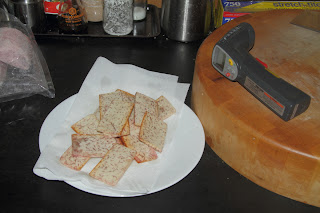Friday, April 5, 2013
steamed pork belly with taro 香芋扣肉
I have a small piece of pork belly left which I was pondering on how to cook it. Since it has been awhile since I I made steamed pork belly with salted radish leaves 梅菜扣肉 I decided to make it again.
steamed pork belly with salted radish leaves 梅菜扣肉 that i made a few months ago
I search for the salted radish leaves 梅菜. I must have used up the previous package but fortunately I have this new package that I bought from store awhile ago.
i open this new package of salted radish leaves 梅菜 - judging from the appearance it should be decent
The biggest challenge in making steamed pork belly with salted radish leaves 梅菜扣肉 is controlling the salt content. Each batch of the salted radish leaves are different and you have to rinse them in water many times to remove all but the last trace of salt. The residual salt would form a big part of the dish's seasoning.
When I open the package I notice the ingredient label list sugar. This is odd. salted radish leaves 梅菜should only contain salt and never sugar. OK, a bit of sugar won't hurt as you would add some sugar to balance this relatively salty dish. Just rinse it once I gave it a taste. It certainly is sweet. They must have used a lot of sugar, I thought to myself...
ingredients include mustard green, salt, and sugar
i cut the thick stems into thin strips to rinse out the salt faster
because the leaves are very thin i add them into the water later
After a few cycles of rinsing the saltiness greatly reduced. It was odd that they still tasted so sweet. Something does not add up because the sugar should diminish equally as quick as the saltiness, if not faster. I then realize the reason they didn't was this was no sugar, but cheap sugar substitute like saccharin. No matter how hard I rinse and squeeze the mustard green 梅菜 I cannot wash off the disgusting saccharin taste. I knew if I use them they would just ruin the dish. I discard the washed mustard green 梅菜. This is a prime example of adulterated food from China (PROC).
What am I going to do now with the pork belly that I already have the skin fried for this dish? Fortunately I have a package of taro in my refrigerator. I can make steamed pork belly with taro 香芋扣肉. I have not make this dish for eons.
So what is steamed pork belly with taro 香芋扣肉? It is the sister dish of steamed pork belly with salted radish leaves 梅菜扣肉. Both dish uses pork belly and the end result are meat that is full of flavor that melts in the mouth. Both are relatively humble dish with very affordable ingredients. They however requires quite a bit of work and cooking time.
this is a big taro
cut them into slices about the size of the pork belly slices
deep fry them briefly will make them melt-in-the-mouth after steaming - i use the digital thermostat to check the oil temperature (it is an indispensable kitchen tool)
For the preperation of the pork belly I use the same photos in my previous post.
briefly blanch it
coat the skin with dark soy sauce
then dry them in oil to create blisters on the skin
The pork belly is then cut into slices to be assembled with the taro later.
this red bean curd 南乳 is the key to this dish - the red color is from the fermented rice; i juse 1 1/2 piece together with some of the liquid
a bit of sugar and i have my hand ready to do the mashing
wrong hand - i prefer my right hand so i have to hold my DSLR with my left to take this photo; i mashed the slices of pork belly so they cover evenly with the paste
next step is to assemble the pork belly with the taro, alternating a piece of pork with a piece of taro; they are placed into a big ceramic bowl with the pork skin down
i then add a bit of water to the bowl to recover the last trace of the paste and added to the bowl
now steam them until the taro and the meat are melt in the mouth tender
i used this $3000 egg timer (my Miele oven) to remind me two hours later; joking aside it is the most use feature of this kitchen appliance
they are melt in the mouth tender
i lined the plate with pieces of steamed napa cabbage
by inverting the content of the bowl onto the plate the pork skin now faces up for proper presentation; the juice is then drained out and thicken with corn starch to top the dish
this dish is always eaten with a bowl of plain rice
the photo does not do it justice - the pork and the taro are tasty and different from any Chinese dish most people ever experience; the red bean curd 南乳 is the back bone of this dish
as a dinner this photo how little the dish is consumed when done eating - the flavor is very concentrated; the taste is best described in chinese as 甘香 which loosely translates as long lingering umami
Both steamed pork belly with salted radish leaves 梅菜扣肉 and steamed pork belly with taro 香芋扣肉 are classic folk dishes of China. The ingredients are quite humble but the end result is loved by most. Both dishes employ preserved food which vast variety is little known to the West. I personally prefer the former because taro can make you quite full when eaten with a bowl of rice. That is the reason I kept the slices very thin.
Subscribe to:
Post Comments (Atom)



























No comments:
Post a Comment